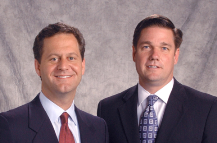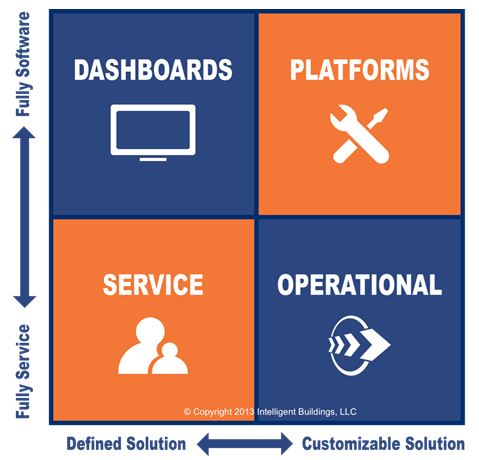|
July 2013
Interview
AutomatedBuildings.com
|
[an error occurred while processing this directive]
(Click
Message to Learn More)
|
EMAIL
INTERVIEW
– Tom Shircliff, Rob Murchison and Ken Sinclair
 Tom
Shircliff and Rob Murchison are the principals of Intelligent
Buildings, LLC,
a smart real estate professional services company that they co-founded
in 2004. Intelligent Buildings provides planning and implementation
management of next generation strategy for new buildings, existing
portfolio optimization and smart community projects. Intelligent
Buildings has worked extensively throughout North America in over 50
different cities.
Tom
Shircliff and Rob Murchison are the principals of Intelligent
Buildings, LLC,
a smart real estate professional services company that they co-founded
in 2004. Intelligent Buildings provides planning and implementation
management of next generation strategy for new buildings, existing
portfolio optimization and smart community projects. Intelligent
Buildings has worked extensively throughout North America in over 50
different cities.
Tom and Rob have been recognized for numerous industry firsts including
lead consulting on "The Smartest Building in America", conception and
development of a Clinton Global Initiative public private partnership,
development and program management for the largest building energy
analytics project in the North America and creation of federal smart
building standards. Additionally, they have been name one of “35 to
watch” in the industry.
They
also help shape the industry through collaboration, advisory and
lecturing at national laboratories and universities including Lawrence
Berkeley National Laboratories, Pacific Northwest National
Laboratories, Harvard University Graduate School of Design, Wake Forest
University School of Business, UNC Charlotte and Georgia Tech
University College of Architecture.
Organizing the Energy Analytics Marketplace
Customers say they were indeed getting dizzy
from all the vendor
messaging and pitches and this helps frame the
marketplace.
Sinclair:
The energy analytics industry has
been growing rapidly which has spawned a number of different types of
companies and solutions. Does your company track the ongoing
developments in this industry segment?
IntelligentBuildingsŪ:
We do have to track the industry for our customers in order to provide
the best guidance for them. However, our research is not just an
exercise or theoretical opining. While we are engaged to provide a
“state of the industry” report, more often we are helping a portfolio
owner to get to an actual solution implementation with quantifiable
results.
Sinclair:
OK, but to provide an actual
solution, isn’t that a matter of
referring to your latest research to see who is best at the time of
your recommendation?
IntelligentBuildingsŪ:
We used to think so but things have changed quite a bit recently. Just
a few years ago it was in fact a matter of “who is best” since there
were relatively few options and you could make real progress by just
picking the best of the lot. Now there are many more options and still
more legacy companies evolving or rebranding themselves as “energy
analytics”. This has created noise in the marketplace and some
confusion among buildings owners/managers because they were frequently
comparing apples to oranges. We determined that it was necessary
to categorize the different types of offerings.
Sinclair:
That makes sense, but did you
find logical categories and to what end?
IntelligentBuildingsŪ:
We did indeed find logical categories. Although it is important to note
that this was born from a customer perspective, not a solution provider
perspective. In other words, when working with the end in mind, we have
to consider the building owner/manager knowledge, resources, property
management processes and aims for analytics. Thus, when we grouped the
service providers we then began a process for matching the customer
profile to the solution provider profile. That is the goal of this… to
match the customer profile with service provider profiles and then only
evaluate those solution companies that are a categorical match.
Sinclair:
So, what are the segments or
groups and how does it work?
IntelligentBuildingsŪ:
We found
four main solution types in the
marketplace that were influenced by two characteristic spectrums.
The characteristics were simply
- the degree of software dependency and
- the degree of customization.
So, on the y-axis we created the range
of software vs people centric
solutions. On the x-axis we created the range for defined vs.
customizable solutions. We then labeled the quadrants with the four
solution types we discovered:
- Dashboards
– – Energy dashboards that track real time usage and trends and then
derive analytical insights from that information. This approach is
faster to implement and less involved with operational change.
- Platforms
– More traditional software purchases that require licensing, hosting
and some capability to manage the data gathering, interpretation and
action plan. A third party integrator may often accompany these
solutions. This is more of a strategy ownership approach and seeks to
change operational processes.
- Services
– People centered services that have a high touch approach that often
includes at least monthly calls do discuss data interpretation; action
plans and follow up on previous calls. This is more of an outsourcing
method when internal resource constraints may be present.
- Operational
– These solutions access and optimize the actual building systems
operational configuration, sequences of operations and routines and
seek to optimize them strategically and automatically.

Sinclair:
What has the reaction been from
building owners/managers and
the solution providers?
IntelligentBuildingsŪ:
Its been fantastic. We have talked to dozens of each and the customers
say they were indeed getting dizzy from all the vendor messaging and
pitches and this helps frame the marketplace - but more importantly
helps them think about themselves and what type of solution they should
be looking for. As to the solution providers, we did not approach this
as merely as our educated opinion. Rather we sent out an extensive
survey to dozens of providers and then talked with them on the phone or
in person to get agreement on the rationale for their position in the
quadrants. They realized that this is not a rating system (which can
come later during a proper evaluation for individual customers), that
no quadrant was necessarily better than another and that it actually
serves them well not to spend a lot of sales time on a mismatched
opportunity.
[an error occurred while processing this directive]Sinclair:
Where have you put the word out
about this?
IntelligentBuildingsŪ:
We
announced this at Realcomm / IBcon in
Orlando and had a full three days with the industry to discuss it and
get feedback. We were very grateful to do it there and to get such an
enthusiastic reaction from all corners. We talked a lot about analytics
during our “Conference Live” interview at IBcon but also in an
interview with “Control
Talk Now Live”.
We are using the quadrants and our step
by step measured, methodology on a daily basis with our customers but
we feel good that this will also help the industry and the adoption
rate of energy analytics overall. This is a powerful low-cost,
high-value solution that is right for the times.
Sinclair:
What else is Intelligent
Buildings up to in the marketplace?
IntelligentBuildingsŪ:
We are spending a lot of time on analytics in the commercial,
corporate, healthcare and government spaces but we are also working on
some iconic, new development projects that are leveraging our
convergence experience during the design-development process and we
continue to be active in the smart community segment, building on the
success of
Envision Charlotte which is a Clinton Global
Initiative that connected 22 million square feet and 65 buildings in
urban Charlotte, NC.
footer
[an error occurred while processing this directive]
[Click Banner To Learn More]
[Home Page] [The
Automator] [About] [Subscribe
] [Contact
Us]
 Tom
Shircliff and Rob Murchison are the principals of Intelligent
Buildings, LLC,
a smart real estate professional services company that they co-founded
in 2004. Intelligent Buildings provides planning and implementation
management of next generation strategy for new buildings, existing
portfolio optimization and smart community projects. Intelligent
Buildings has worked extensively throughout North America in over 50
different cities.
Tom
Shircliff and Rob Murchison are the principals of Intelligent
Buildings, LLC,
a smart real estate professional services company that they co-founded
in 2004. Intelligent Buildings provides planning and implementation
management of next generation strategy for new buildings, existing
portfolio optimization and smart community projects. Intelligent
Buildings has worked extensively throughout North America in over 50
different cities.